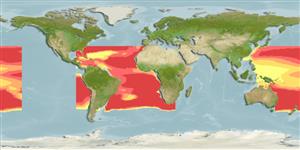Environment: milieu / climate zone / depth range / distribution range
Écologie
marin; profondeur ? - 775 m (Ref. 86942). Tropical; 35°N - 49°S, 89°W - 154°W
Eastern Atlantic: Madeira and off Cape Town, South Africa (Ref. 6597). Western Atlantic: in tropical waters. Western Pacific: off the Ogasawara Islands (Ref. 559), Australia (Ref. 7300), and New Zealand (Ref. 5755). Reported from the Hawaiian Islands (Ref. 58302).
Taille / Poids / Âge
Maturity: Lm ? range ? - ? cm
Max length : 16.0 cm SL mâle / non sexé; (Ref. 6542)
Description synthétique
Clés d'identification | Morphologie | Morphométrie
Épines dorsales (Total) : 0; Rayons mous dorsaux (Total) : 10 - 12; Épines anales: 0; Rayons mous anaux: 7 - 10. Scattered melanophores ventrally; pelvic fins and area around anus black; head translucent (Ref. 6597). Body compressed. Brown in preserved specimen, with black pigment cells scattered in lower half (Ref. 37473).
Mesopelagic (Ref. 58302). Eggs and larvae are pelagic. Does not exhibit diurnal vertical migration (Ref. 6686).
Life cycle and mating behavior
Maturities | Reproduction | Spawnings | Egg(s) | Fecundities | Larves
Quéro, J.-C., 1990. Opisthroproctidae. p. 241-243. In J.C. Quero, J.C. Hureau, C. Karrer, A. Post and L. Saldanha (eds.) Check-list of the fishes of the eastern tropical Atlantic (CLOFETA). JNICT, Lisbon; SEI, Paris; and UNESCO, Paris. Vol. 1. (Ref. 6542)
Statut dans la liste rouge de l'IUCN (Ref. 130435)
Menace pour l'homme
Harmless
Utilisations par l'homme
Outils
Articles particuliers
Télécharger en XML
Sources Internet
Estimates based on models
Preferred temperature (Ref.
123201): 12.4 - 23.5, mean 17.8 °C (based on 262 cells).
Phylogenetic diversity index (Ref.
82804): PD
50 = 1.0000 [Uniqueness, from 0.5 = low to 2.0 = high].
Bayesian length-weight: a=0.02188 (0.00844 - 0.05670), b=2.98 (2.75 - 3.21), in cm total length, based on LWR estimates for this (Sub)family-body shape (Ref.
93245).
Niveau trophique (Ref.
69278): 3.7 ±0.1 se; based on size and trophs of closest relatives
Résilience (Ref.
120179): Milieu, temps minimum de doublement de population : 1,4 à 4,4 années (Preliminary K or Fecundity.).
Fishing Vulnerability (Ref.
59153): Low vulnerability (10 of 100).
